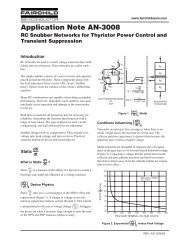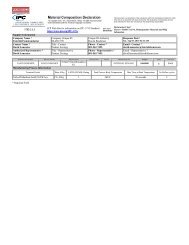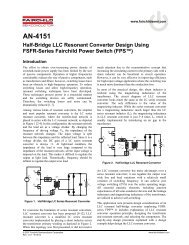AN-6094 Design Guideline for Flyback Charger Using FAN302HL/UL
AN-6094 Design Guideline for Flyback Charger Using FAN302HL/UL
AN-6094 Design Guideline for Flyback Charger Using FAN302HL/UL
You also want an ePaper? Increase the reach of your titles
YUMPU automatically turns print PDFs into web optimized ePapers that Google loves.
<strong>AN</strong>-<strong>6094</strong><br />
4. <strong>Design</strong> Procedure<br />
In this section, a design procedure is presented using the<br />
Figure 1 as a reference. An offline charger with 6 W / 5 V<br />
output has been selected as a design example. The design<br />
specifications are:<br />
Line Voltage Range: 90~264 VAC and 60 Hz<br />
Nominal Output Voltage and Current: 5 V / 1.2 A<br />
Output Voltage Ripple: Less than 100 mV<br />
Minimum Output Voltage in CC Mode: 25% of<br />
Nominal Output (1.25 V)<br />
Maximum Switching Frequency: 140 kHz<br />
Figure 7. Output Voltage and Current Operating Area<br />
[STEP-1] Estimate the Efficiencies<br />
The charger application has output voltage and current<br />
that change over a wide range, as shown in Figure 7,<br />
depending on the charging status of the battery. Thus, the<br />
efficiencies and input powers of various operating<br />
conditions should be specified to optimize the power stage<br />
design. The critical operating points <strong>for</strong> design:<br />
Operating Point A, where the output voltage and<br />
current reach maximum value (nominal output<br />
voltage and current).<br />
Operating Point B, where the frequency drop is<br />
initiated to maintain DCM operation.<br />
Operating Point C, where the output has its<br />
minimum voltage in CC Mode.<br />
Typically, low line is the worst case <strong>for</strong> the trans<strong>for</strong>mer<br />
design since the largest duty cycle occurs at the minimum<br />
input voltage condition. As a first step, the following<br />
parameters should be estimated <strong>for</strong> low line.<br />
Estimated overall efficiency <strong>for</strong> operating points A, B,<br />
and C (EFF@A, EFF@B, and EFF@C): The overall power<br />
conversion efficiency should be estimated to calculate<br />
the input power and maximum DC link voltage ripple.<br />
If no reference data is available, use the typical<br />
efficiencies in Table 1.<br />
Estimated primary-side efficiency (EFF.P) and<br />
secondary-side efficiency (EFF.S) <strong>for</strong> operating point A,<br />
B, and C. Figure 8 shows the definition of primaryside<br />
and secondary-side efficiencies. The primary-side<br />
efficiency is <strong>for</strong> the power transferred from the AC<br />
line to the trans<strong>for</strong>mer primary side. The secondaryside<br />
efficiency is <strong>for</strong> the power transferred from the<br />
trans<strong>for</strong>mer primary side to the power supply output.<br />
Since the rectifier diode <strong>for</strong>ward voltage drop does not<br />
change much with its voltage rating, the conduction loss<br />
of output rectifier diode tends to be dominant <strong>for</strong> a low<br />
output voltage application. There<strong>for</strong>e, the distribution of<br />
primary-side and secondary-side efficiencies changes with<br />
the output voltage. With a given trans<strong>for</strong>mer efficiency,<br />
the secondary- and primary-side efficiency, ignoring the<br />
diode switching loss, are given as:<br />
N<br />
VO<br />
FF. S ≅ FF. TX ⋅<br />
N<br />
VO + VF<br />
E E<br />
EFF. P = EFF / EFF.<br />
S<br />
(3)<br />
where EFF.TX is trans<strong>for</strong>mer efficiency, typically<br />
0.95~0.98%; VO N is the nominal output voltage; and<br />
VF is the rectifier diode <strong>for</strong>ward-voltage drop.<br />
© 2012 Fairchild Semiconductor Corporation www.fairchildsemi.com<br />
Rev. 1.0.0 • 9/27/12 4<br />
(2)<br />
Table 1. Typical Efficiency of <strong>Flyback</strong> Converter<br />
Output<br />
Voltage<br />
Typical Efficiency at Minimum<br />
Line Voltage<br />
Universal Input European Input<br />
3.3 ~ 6 V 65 ~ 70% 67 ~ 72%<br />
6 ~ 12 V 70 ~ 77% 72 ~ 79%<br />
12 ~ 24 V 77 ~ 82% 79 ~ 84%<br />
Figure 8. Primary-Side and Secondary-Side Efficiency<br />
With the estimated overall efficiency, the input power at<br />
operating point A is given as:<br />
P<br />
IN @ A<br />
N N<br />
VO<br />
IO<br />
= (4)<br />
E<br />
FF @ A<br />
where VO N and IO N are the nominal output voltage and<br />
current, respectively.








